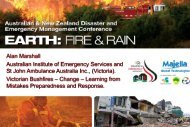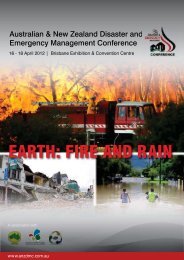Book of Abstracts 2013 - Australian and New Zealand Disaster ...
Book of Abstracts 2013 - Australian and New Zealand Disaster ...
Book of Abstracts 2013 - Australian and New Zealand Disaster ...
Create successful ePaper yourself
Turn your PDF publications into a flip-book with our unique Google optimized e-Paper software.
Area <strong>of</strong> NSW’s Emergency Management Plan embarked on planning the evacuation response <strong>and</strong> arrangements for the<br />
care <strong>of</strong> the community. This resulted in development <strong>and</strong> erection <strong>of</strong> a 500 bed major evacuation centre (MEC) at<br />
Deniliquin, 124 kilometres distant. <strong>Disaster</strong> Welfare Services Alumni managed the DW Unit, support by local<br />
Community Services staff. Multiple issues were identified <strong>and</strong> resolved by this team <strong>and</strong> implications for future<br />
planning <strong>and</strong> practice articulated. Some <strong>of</strong> these key issues are explored in the paper: Remoteness <strong>of</strong> the intervention<br />
<strong>and</strong> supervision <strong>and</strong> support for the welfare team Responding to the needs <strong>of</strong> vulnerable groups within the evacuated<br />
community Culturally sensitive practice Information provision Planning leisure activities/managing boredom<br />
Interagency liaison, joint interventions, <strong>and</strong> referrals Occupational health <strong>and</strong> safety issues Managing the community<br />
meetings, tensions <strong>and</strong> psychosocial issues within the evacuated community Impacts on the host community Managing<br />
the return process Managing local, regional <strong>and</strong> state level processes <strong>and</strong> relationships within the emergency<br />
management agencies.<br />
A/Pr<strong>of</strong> Jane Shakespeare-Finch<br />
Associate Pr<strong>of</strong>essor, Queensl<strong>and</strong> University <strong>of</strong> Technology<br />
Co Author - Mrs Julie Green, student, Queensl<strong>and</strong> University <strong>of</strong> Technology<br />
Social support promotes psychological well-being following a natural disaster<br />
Receiving emotional support has consistently been demonstrated as an important factor associated with mental health<br />
but sparse research has investigated giving support in addition to receiving it or the types <strong>of</strong> support that predict wellbeing.<br />
In this paper the relationship between giving <strong>and</strong> receiving instrumental <strong>and</strong> emotional social support <strong>and</strong><br />
psychological well-being during <strong>and</strong> following a natural disaster is investigated. A survey administered between four<br />
<strong>and</strong> six months after fatal floods was conducted with 200 community members consisting <strong>of</strong> men (n = 68) <strong>and</strong> women<br />
(n = 132) aged between 17 <strong>and</strong> 87 years. Social support experiences were assessed using the 2-Way Social Support<br />
Scale (2-Way SSS; Shakespeare-Finch & Obst, 2011) <strong>and</strong> eudemonic well-being was measured using the Psychological<br />
Well-Being Scale (PWBS; Ryff & Keyes, 1995). Hierarchical multiple regression analyses were used to examine expected<br />
relationships <strong>and</strong> to explore the differential effects <strong>of</strong> the four factors <strong>of</strong> the 2-Way SSS. Results indicated that social<br />
support shared significant positive associations with domains <strong>of</strong> psychological well-being, especially with regards to<br />
interpersonal relationships. Receiving <strong>and</strong> giving emotional support were respectively the strongest unique predictors<br />
<strong>of</strong> psychological well-being. However, receiving instrumental support predicted less autonomy. Results highlight the<br />
importance <strong>of</strong> measuring social support as a multidimensional construct <strong>and</strong> affirm that disaster response policy <strong>and</strong><br />
practice should focus on emotional as well as instrumental needs in order to promote individual <strong>and</strong> community<br />
psychosocial health in a flooding crisis.<br />
Dr Deborah Snell<br />
Clinical Senior Lecturer, University <strong>of</strong> Otago at Christchurch<br />
Co Authors - Associate Pr<strong>of</strong>essor Lois Surgenor, Associate Pr<strong>of</strong>essor, University <strong>of</strong> Otago at Christchurch. Associate<br />
Pr<strong>of</strong>essor Martin Dorahy, Associate Pr<strong>of</strong>essor, University <strong>of</strong> Canterbury.<br />
Application <strong>of</strong> the Conservation <strong>of</strong> Resources Theory to underst<strong>and</strong>ing coping <strong>and</strong><br />
adjustment in Police staff 12-18 months following the Canterbury earthquakes.<br />
AIM Police as a large <strong>and</strong> stable ‘first responder’ work force are typically involved in victim recovery, civil emergencies<br />
<strong>and</strong> community support following a significant earthquake. In addition this group are also exposed to the ‘everyday’<br />
work <strong>and</strong> non-work related repercussions/disruptions associated with such a disaster. Conservation <strong>of</strong> resources<br />
(COR) theory <strong>of</strong>fers a potentially helpful framework within which longer term health outcomes associated with disaster






